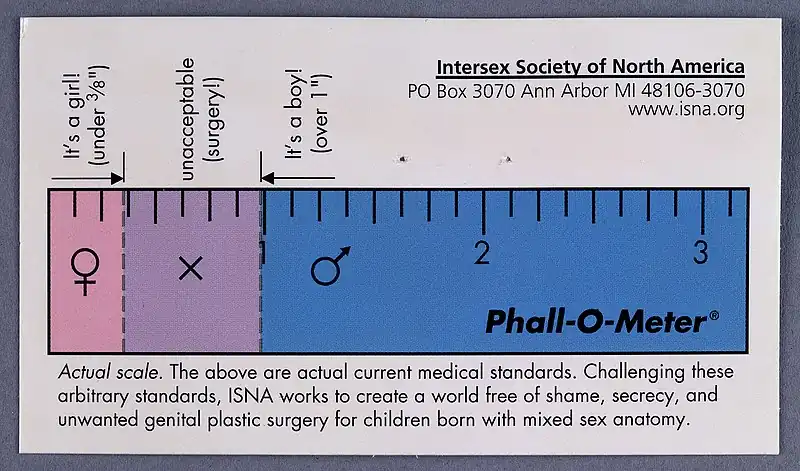Phall-O-Meter
The Phall-O-meter is a satirical measure that critiques medical standards for normal male and female phalluses.[1][2][3] The tool was developed by Kiira Triea (Denise Tree) based on a concept by Suzanne Kessler and is used to demonstrate concerns with the medical treatment of intersex bodies.
Schematic representation

History
The Phall-O-meter was developed by Kiira Triea[4][5] based on a concept by professor of psychology Suzanne Kessler. Kessler summarized the range of medically acceptable infant penis and clitoris sizes in the book Lessons from the Intersexed.[6] Kessler states that normative tables for clitoral length appeared in the late 1980s, while normative tables for penis length appeared more than forty years before that. She combined those standard tables to demonstrate an "intermediate area of phallic length that neither females nor males are permitted to have", that is, a clitoris larger than 9mm or a penis shorter than 25mm.[6]
The meter was printed by the now-defunct Intersex Society of North America as a means of demonstrating concerns with the medical treatment of intersex people.[5][7][8][9]
In her 2000 book Sexing the Body, Anne Fausto-Sterling describes how members of the intersex rights movement had developed a "phall-o-meter".[10] Fausto-Sterling notes that, despite the existence of normative tables, clinicians' practices are more subjective: "doctors may use only their personal impressions to decide" on an appropriate clitoris size.[11] Similarly, in a paper presented to the American Sociological Association in 2003, Sharon Preves cites Melissa Hendricks, writing in the Johns Hopkins Magazine, November 1993 on subjective clinical norms and their relationship to surgical management:[12]
In truth, the choice of gender still often comes down to what the external genitals look like. Doctors who work with children with ambiguous genitalia sometimes put it this way, "You can make a hole [vagina] but you can't build a pole [penis]." Surgeons can decrease the size of a phallus and create a vagina, but constructing a penis that will grow as the child grows is another matter [...]
Copies of the Phall-O-Meter are now held by the Wellcome Library in London,[13] and the Smithsonian Institution.[14]
Related concepts
While the scale as used by the Intersex Society of North America was a satirical tool for activism, numerous clinical scales and measurement systems exist to define genitals as normal male or female, or "abnormal", including the orchidometer,[15] Prader scale[16] and Quigley scale.[17]
See also
References
- ↑ Bhattacharya, Sanjoy (2009). "Teratology and the clinic: John William Ballantyne and the making of antenatal life". Wellcome History. 1–24.
- ↑ Marchal, Joseph (2010-07-03). "Bodies Bound for Circumcision and Baptism: An Intersex Critique and the Interpretation of Galatians". Theology & Sexuality. 16 (2): 163–182. doi:10.1558/tse.v16i2.163. ISSN 1355-8358. S2CID 143514837. Retrieved 2016-04-19.
- ↑ García López, Daniel J (March 2015). "La intersexualidad en el discurso médico-jurídico". Eunomía (8): 54–70. ISSN 2253-6655.
- ↑ Larochelle, Renée (June 7, 2012). "La vie secrète du troisième sexe". Le Fil. 47 (32). Archived from the original on January 6, 2021. Retrieved January 4, 2021.
- 1 2 Dreger, Alice (February 12, 2008), A note on Kiira Triea's place in the history of intersex activism
- 1 2 Kessler, Suzanne (1998). Lessons from the Intersexed. New Brunswick, New Jersey: Rutgers University Press. p. 43. ISBN 0-8135-2530-6.
- ↑ White, Ryan L. (2013). "Preferred Private Parts: Importing Intersex Autonomy for M.C. v. Aaronson". Fordham International Law Journal. 37: 777.
- ↑ Intersex Society of North America (2005). "Hermaphrodites With Attitude, Winter 2005" (PDF). Hermaphrodites With Attitude.
- ↑ Feder, E. K. (January 1, 2009). "Imperatives of Normality: From "Intersex" to "Disorders of Sex Development"". GLQ: A Journal of Lesbian and Gay Studies. 15 (2): 225–247. doi:10.1215/10642684-2008-135. ISSN 1064-2684. S2CID 145807168. Retrieved 2014-10-23.
- ↑ Fausto-Sterling, Anne (2000). Sexing the Body. New York: Basic Books. p. 59. ISBN 0-465-07714-5.
- ↑ Fausto-Sterling, Anne (2000). Sexing the Body. New York: Basic Books. p. 60. ISBN 0-465-07714-5.
- ↑ Preves, Sharon (August 16, 2003). "Hermaphrodites With Attitude: The Intersex Patients' Rights Movement and Clinical Reform". annual meeting of the American Sociological Association.
- ↑ "L0031936". Wellcome Library.
- ↑ Dreger, Professor Alice D. (2006). "Intersex and Human Rights: The Long View". In E. Sytsma, Sharon (ed.). Ethics and Intersex. International Library of Ethics, Law and the New Medicine. Vol. 29. Springer Netherlands. pp. 73–86. doi:10.1007/1-4220-4314-7_4. ISBN 978-1-4020-4314-7. Retrieved 2016-04-19.
- ↑ Januś, Dominika; Wójcik, Małgorzata; Starzyk, Jerzy B. (2023-01-01). "Testicular microlithiasis in paediatric patients with Klinefelter syndrome from infancy till adolescence: early start of degenerative process in the testes—preliminary results". European Journal of Pediatrics. 182 (1): 225–235. doi:10.1007/s00431-022-04663-w. ISSN 1432-1076. PMC 9829623. PMID 36282322.
- ↑ Australia (2013). Involuntary or coerced sterilisation of intersex people in Australia. Canberra: Community Affairs References Committee. ISBN 978-1-74229-917-4
- ↑ Quigley CA, De Bellis A, Marschke KB, el-Awady MK, Wilson EM, French FS (June 1995). "Androgen receptor defects: historical, clinical, and molecular perspectives". Endocr. Rev. 16 (3): 271–321. doi:10.1210/edrv-16-3-271. PMID 7671849.